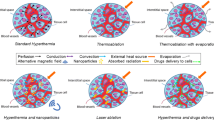Abstract
A novel numerical model to simulate thermal response of human body tissues exposed to RF energy is presented in this article. It is based on a new algorithm for the construction of a realistic blood vessel network, a new model of blood flow velocity distribution and an approach to solve the bio-heat equation in human tissue with variable and initially unknown blood temperature distribution. The algorithm generates a discrete 3D representation of both arterial and venous vascular networks and a continuous blood velocity vector field for arbitrary enclosed geometries required to represent the complex anatomy of human body and blood flow. The results obtained in this article by applying the developed method to realistic exposure conditions demonstrates relative difference in thermal response of the exposed tissue compared to results obtained by conventional bio-heat equation with constant blood perfusion and temperature. The developed technique may provide more accurate and realistic modelling in thermal dosimetry studies of human body RF exposure.















Similar content being viewed by others
References
Pennes HH (1948) Analysis of tissue and arterial blood temperatures in the resting human forearm. J Appl Physiol 1:93–102
Bernardi P, Cavagnaro M, Pisa S, Piuzzi E (2003) Specific absorption rate and temperature elevation in a subject exposed in the far-field of radio-frequency sources operating in the 10–900-MHz range. IEEE Trans Biomed Eng 50:295–304
Kotte A, van Leeuwen G, de Bree J, van der Koijk J, Crezee H, Lagendijk J (1996) A description of discrete vessel segments in thermal modeling of tissues. Phys Med Biol 41:865–884
Hirata A, Fujiwara O (2009) Modeling time variation of blood temperature in a bioheat equation and its application to temperature analysis due to RF exposure. Phys Med Biol 54:N189–N196
Mooibroek J, Lagendijk JJ (1991) A fast and simple algorithm for the calculation of convective heat transfer by large vessels in three-dimensional inhomogeneous tissues. IEEE Trans Biomed Eng 38(5):490–501
Flyckt VM et al (2007) Calculation of SAR and temperature rise in a high-resolution vascularized model of the human eye and orbit when exposed to a dipole antenna at 900, 1500 and 1800 MHz. Phys Med Biol 52:2691–2701
Buccella C, De Santis V, Feliziani M (2007) Prediction of temperature increase in human eyes due to RF sources. IEEE Trans EMC 49(4):825–833
Kakulia D, Manukyan L, Prishvin M, Jeladze V, Zaridze R, Bit-Babik G, Faraone G (2008) Vascular structure construction in human model for consideration of blood flow in heat exchange during em exposure. In: EUROEM 2008 European electromagnetics, 21–25 July 2008, Swiss Federal Institute of Technology (EPFL), Lausanne, Switzerland, pp 166
Prishvin M, Manukyan L, Jeladze V, Petoev I, Tabatazde V, Kakulia D, Zaridze R (2008) Numerical simulation of heat transfer in human tissue according to improved vascular structure model. In: Proceedings of XIIIth international seminar/workshop on direct and inverse problems of electromagnetic and acoustic wave theory (DIPED-2008), 22–25 Sep 2008, Tbilisi, Georgia, pp 143–148
Prishvin, M, Manukyan L, Zaridze R (2009) Vascular structure model for improved numerical simulation of heat transfer in human tissue. In: 20-th international Zurich symposium on electromagnetic compatibility, 12–16 Jan 2009, Zurich, Switzerland, pp 261–264
Bit-Babik G, Prishvin M, Kakulia D, Zaridze R, Faraone A (2009) Modified bio-heat equation according to new vascular system model. In: Technical program, Davos Congress Center, Davos, Switzerland, 14–19 June 2009, pp 774–775. http://bioem2009.org/technical-program
Van Leeuewen GMJ, Kotte ANTJ, Lagendijk JJW (1998) A flexible algorithm for construction of 3-D vessel networks for use in thermal modeling. IEEE Trans Biomed Eng 45:596–604
Murray C (1926) The physiological principle of minimum work: I. The vascular system and the cost of blood volume. Proc Natl Acad Sci USA 12:207–214
Zaridze R, Bit-Babik G, Tavzarashvili K, Uzunoglu N, Economou D (2002) Wave field singularity aspects large-size scatterers and inverse problems. IEEE Trans Antennas Propag 50(1):50–58
Tikhonov A, Samarski A (1966) Equations of mathematical physics. Nauka, Moscow, p 459 (in Russian)
Shoshiashvili L, Razmadze A, Jejelava N, Zaridze R, Bit-Babik LG, Faraone A (2006) Validation of numerical bioheat FDTD model. In: Proceedings of XIth international seminar/workshop on direct and inverse problems of electromagnetic and acoustic wave theory (DIPED-2006), 11–13 Oct 2006, Tbilisi, Georgia, pp 201–204
Christ A et al (2010) The Virtual Family—development of surface-based anatomical models of two adults, two children for dosimetric simulations. Phys Med Biol 55:N23–N38
Raaymakers BW (2001) Thermal modelling for hyperthermia. Tekst, Proefschrift Universiteit Utrecht, p 66. ISBN:90-393-2848-X
Gandhi OP, Li QX, Kang G (2001) Temperature rise for the human head for cellular telephones and for peak SARs prescribed in safety guidelines. IEEE Trans Microwave Theory Tech 49:1607–1613
Bernardi P, Cavagnaro M, Pisa S, Piuzzi E (2000) Specific absorption rate and temperature increases in the head of a cellular-phone user. IEEE Trans Microwave Theory Tech 48:1118–1126
Flyckt V, Raaymakers B, Lagendijk J (2006) Modeling the impact of blood flow on the temperature distribution in the human eye and the orbit: fixed heat transfer coefficients versus the Pennes bioheat model versus discrete blood vessels. Phys Med Biol 51:5007–5021
Author information
Authors and Affiliations
Corresponding author
Rights and permissions
About this article
Cite this article
Prishvin, M., Zaridze, R., Bit-Babik, G. et al. Improved numerical modelling of heat transfer in human tissue exposed to RF energy. Australas Phys Eng Sci Med 33, 307–317 (2010). https://doi.org/10.1007/s13246-010-0041-5
Received:
Accepted:
Published:
Issue Date:
DOI: https://doi.org/10.1007/s13246-010-0041-5




